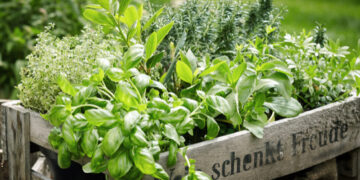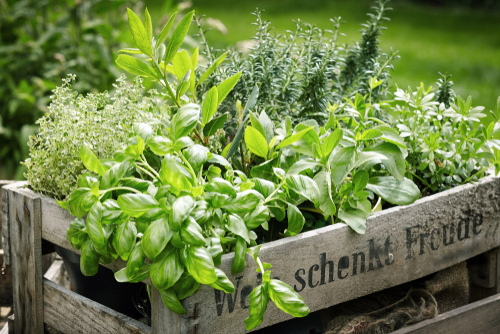From Garden to Kitchen, One Leaf at a Time
There’s a kind of quiet magic in herbs—the way a single sprig of rosemary can deepen a stew, or a few torn basil leaves can lift a summer salad into something unforgettable. On our farm, the herb beds were small but mighty, tucked between rows of vegetables or lining the edge of the kitchen garden. Each season brought its own stars: spring’s delicate chives, summer’s lush basil, fall’s earthy sage. Tending these plants, snipping them fresh, and folding them into our meals was second nature. These were not garnish—they were the soul of the dish.
The Rhythm of Herbal Life
Like all good things from the soil, herbs follow a rhythm. Some rise early with the first green shoots of spring; others prefer the full heat of summer. Many fade by frost, while a few stand sturdy through snow. Knowing when to grow, harvest, and cook with herbs brings you closer to the natural world—and adds deeper flavor and freshness to every meal.
Spring: Tender Shoots & Bright Flavors
Key Herbs:
-
Chives – Grassy, onion-like, and one of the first to emerge.
-
Parsley – Vibrant and clean, perfect for waking up the palate.
-
Mint – Spreads fast and wide once the soil warms.
-
Tarragon – Delicate with an anise note, perfect with eggs and fish.
In the Kitchen:
-
Chive & Goat Cheese Omelet: Fold snipped chives into fluffy eggs with a dollop of goat cheese for a bright, fresh breakfast.
-
Spring Herb Dressing: Blend parsley, mint, olive oil, lemon, and garlic for a green drizzle over greens, grains, or grilled veggies.
-
Tarragon Chicken Salad: Add chopped tarragon to yogurt-based chicken salad with celery and walnuts for a twist on a classic.
Summer: Abundant, Aromatic & Bold
Key Herbs:
-
Basil – Loves heat; grows fast and full with regular pinching.
-
Cilantro – Quick to bolt, so succession plant every few weeks.
-
Dill – Feather-light and fragrant, ideal for pickling and fish.
-
Oregano & Thyme – Hardy perennials that thrive in dry summer beds.
In the Kitchen:
-
Fresh Basil Pesto: Blend basil, garlic, pine nuts, and olive oil into a vibrant paste—perfect for pasta, sandwiches, or grain bowls.
-
Cilantro-Lime Slaw: Toss shredded cabbage with lime juice, olive oil, and chopped cilantro for a crunchy taco topping or salad.
-
Grilled Veggies with Thyme Oil: Brush sliced zucchini, peppers, and eggplant with oil infused with thyme and a touch of lemon.
Fall: Earthy, Warming, and Aromatic
Key Herbs:
-
Sage – Soft, silvery, and strong-flavored—one of fall’s boldest herbs.
-
Rosemary – Evergreen and resinous, often at its best as days grow shorter.
-
Marjoram – Milder cousin to oregano with a citrusy edge.
-
Chervil – Cool-loving, best grown in early fall or late spring.
In the Kitchen:
-
Butternut Squash Soup with Sage: Sauté fresh sage leaves in butter before blending into a creamy roasted squash soup.
-
Rosemary-Rubbed Roasted Potatoes: Chop rosemary finely and mix with sea salt and olive oil before tossing with potatoes to roast.
-
Mushroom & Marjoram Risotto: Add chopped marjoram to the final stir of a rich, savory risotto to brighten the earthiness of mushrooms.
Winter: Evergreens & Indoor Growing
Key Herbs:
-
Rosemary & Thyme – Both evergreen and perfect for winter stews.
-
Bay Leaves – Usually dried but ideal for slow-cooked dishes.
-
Parsley (Indoor Pots) – Grows well in sunny windows, even in winter.
In the Kitchen:
-
Herbed Lentil Stew: Simmer lentils with thyme and bay leaf, then finish with a spoonful of olive oil and chopped parsley.
-
Winter Herb Butter: Mix finely chopped rosemary and thyme into softened butter. Freeze in logs and slice as needed for roasting vegetables or spreading on bread.
-
Root Vegetable Gratin: Layer thinly sliced potatoes and parsnips with cream, garlic, and thyme for a hearty, herb-scented dish.
Ad Banner #1
— Placeholder for your first ad —
Harvesting & Storing Tips
-
Best Time to Harvest:
Pick herbs in the morning after the dew has dried but before the sun is too high—this is when oils (and flavor) are most concentrated. -
Drying:
Air-dry sturdy herbs like thyme, oregano, and sage in bundles hung upside down in a cool, dark place. Strip and store in jars once dry. -
Freezing:
Chop herbs like parsley, basil, or dill and freeze in olive oil in ice cube trays. Perfect for soups, stews, or sauté pans all winter long. -
Indoor Growing:
If frost has arrived, move tender herbs indoors. A sunny windowsill and occasional watering will keep pots of parsley, mint, or basil going through winter.
Ad Banner #2
— Placeholder for your second ad —
Cooking with Intention
Herbs don’t just add flavor—they add freshness, complexity, and a sense of place. A salad brightened with mint in spring, a tomato sauce simmered with oregano in summer, roasted squash with sage in fall—each one tells a story of the season. When you cook with herbs you’ve grown or picked fresh from the market, you create meals that taste alive.
Start Small, Grow Slowly
You don’t need an herb garden to cook seasonally—just a few pots, a patch of sun, or a weekly visit to your farmers market. Start with one or two herbs per season, learn their flavors, and let them guide your kitchen. The more you work with them, the more natural it becomes—just like walking into the garden and picking what’s ready.



























